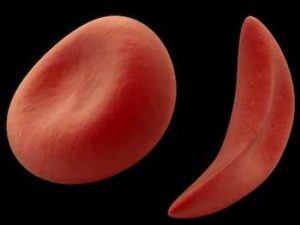
On this date's Registry, we discuss Sickle Cell Anemia. Although it is not a leading cause of death, sickle cell in the United States (and elsewhere in the Americas) occurs predominantly in people of African descent.
Life is studied at the atomic and molecular scale in molecular biology, biochemistry, and molecular genetics. At the level of the cell, it is studied in cell biology. Sickle cell disease is an inherited blood disorder characterized primarily by chronic anemia and periodic pain episodes. The underlying problem involves hemoglobin, a component of the red cells in the blood. They carry oxygen from the lungs to the body's organs and tissues and bring back carbon dioxide to the lungs.
After the hemoglobin molecules give up their oxygen, some may cluster together and form long, rod-like structures. These structures cause the red blood cells to stiffen and assume a sickle shape. Unlike normal red cells, which are usually smooth and donut-shaped, sickled red cells cannot squeeze through small blood vessels. Instead, they stack up and cause blockages that deprive the organs and tissue of oxygen-carrying blood.
This process produces periodic episodes of pain, ultimately damaging the tissues and vital organs and leading to other serious medical problems. The disorder can be traced back to the coastal regions of Africa, where some individuals developed the sickle cell gene mutation as a biological defense; sickle cells destroy malaria-infested parasites invading the bloodstream. The sickle cell mutation also occurs in malaria-infested regions of Italy, Greece, and India. Individuals who inherit the sickle cell trait from one parent rarely suffer ill effects. Individuals who inherit the sickle cell trait from both parents may produce excessive sickle cells. In sickle cell anemia, the hemoglobin is defective.
Unlike normal red blood cells, which last about 120 days in the bloodstream, sickled red cells die after only about 10 to 20 days. Because they cannot be replaced fast enough, the blood is chronically short of red blood cells, a condition called anemia. Roughly 1 in every 400 African Americans suffers from the disorder, usually appearing after six months. Medical research is currently working on a synthetic molecule capable of correcting the gene mutation in sickle-cell patients.
American Medical Association
2441 84th Street
Brooklyn, NY 11214